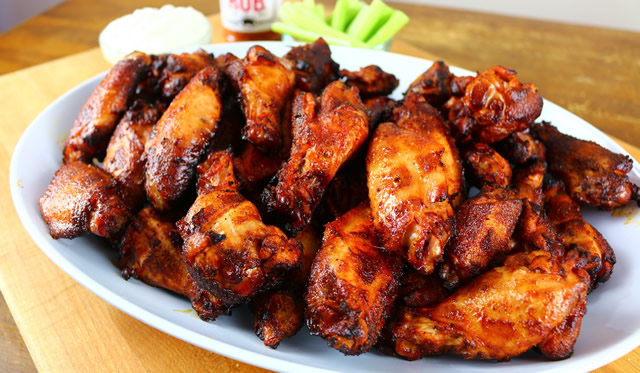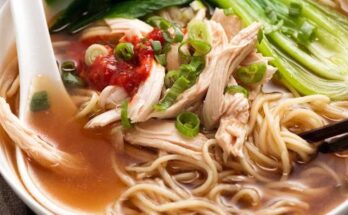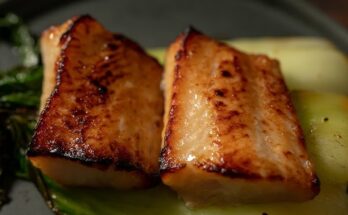Smoked Chicken Wings Recipe: If you’re tired of the same old fried or grilled wings, it’s time to discover why smoked chicken wings are in a league of their own. Smoking infuses the meat with deep, complex flavors that no oven or air fryer can replicate. Think about it—juicy, tender wings with a crispy bite, kissed by the scent of wood smoke. Sound like a flavor explosion? That’s because it is.
What makes smoked wings truly stand out is the balance between texture and taste. The low and slow smoking method allows the connective tissues in the chicken to break down, leaving you with wings that are fall-off-the-bone tender. Whether you’re a backyard BBQ enthusiast or just someone who loves wings, this method brings something extra to the table.
Smoked wings are also extremely versatile. Want them spicy? Sweet? Savory? You control the flavor profile from start to finish. And the best part? They’re surprisingly easy to make once you understand the process.
The Magic of Low and Slow Cooking
The secret to unforgettable smoked wings lies in the “low and slow” philosophy. Smoking at a low temperature (typically around 225°F to 250°F) for a longer time allows the flavors from the wood chips and rubs to penetrate deep into the meat. You’re not just cooking wings—you’re crafting a culinary experience.
This method does more than just cook the chicken. It tenderizes it while locking in natural juices, ensuring the end product isn’t dry or overdone. The smoke acts like a natural flavor enhancer, creating a subtle bark (crust) on the outside without sacrificing tenderness inside.
Unlike grilling, which can quickly overcook wings if you’re not careful, smoking gives you more control. With patience, your wings will reach the perfect balance of smoky flavor, crisp skin, and juicy interior.
Ingredients You’ll Need
Main Ingredients for the Chicken Wings
To make the best smoked chicken wings, the foundation is—obviously—the wings. Always opt for fresh, whole chicken wings if possible. These will have better texture and flavor than pre-cut, frozen options. You can buy them whole and separate the drumette, wingette, and tip yourself, or ask your butcher to do it for you.
Here’s a basic list:
- 2–3 pounds of chicken wings (whole or cut)
- 1–2 tablespoons olive oil (for binding the rub)
- Kosher salt and black pepper to taste
Freshness matters. The better quality your chicken, the better the final result. Organic or pasture-raised wings tend to have a richer flavor, so if your budget allows, go the extra mile.
Essential Dry Rub Spices
A good dry rub is the soul of smoked wings. You can get creative here, but here’s a classic all-purpose blend to get you started:
- 1 tablespoon paprika (smoked or sweet)
- 1 teaspoon garlic powder
- 1 teaspoon onion powder
- 1 teaspoon chili powder
- ½ teaspoon cayenne pepper (adjust for heat)
- 1 teaspoon brown sugar (optional for a caramelized touch)
- 1 teaspoon ground mustard
- Salt and pepper to taste
You can double or triple this mix depending on how many wings you’re making. Mix it thoroughly and store leftovers in a jar for next time. Want a barbecue twist? Add a teaspoon of ground cumin. Prefer a spicy kick? Amp up the cayenne and add crushed red pepper flakes.
Dry rubs do more than add flavor—they help create that crave-worthy crust on the skin once the wings hit the smoker.
Optional Add-ons and Sauces
While dry-rubbed smoked wings are excellent on their own, sauces take things to another level. Whether you’re a fan of spicy Buffalo, sweet BBQ, or tangy garlic Parmesan, the options are endless.
Here are a few optional ingredients you might want to prepare:
- Buffalo sauce (hot sauce + melted butter)
- Honey BBQ glaze
- Garlic Parmesan drizzle
- Ranch or blue cheese dressing (for dipping)
- Fresh herbs (like chopped parsley or green onions for garnish)
- Fresh lime or lemon juice for a zesty finish
Remember, you can always sauce the wings after they’ve smoked, or serve the sauce on the side so everyone can customize their plate.
Tools and Equipment Required
Best Smokers to Use for Chicken Wings
To smoke wings properly, you’ll need a smoker. If you don’t already have one, here are some common types to consider:
- Pellet smokers (like Traeger or Pit Boss): User-friendly, consistent temps, great smoke flavor.
- Offset smokers: Ideal for those who like traditional wood-smoking and more manual control.
- Electric smokers: Easy to use, set-and-forget style, but may not give as strong a smoke flavor.
- Charcoal smokers (like Weber Smokey Mountain): Affordable, smoky flavor, a bit more effort.
- Kamado-style grills (like Big Green Egg): Excellent heat retention, versatile cooking options.
No matter the smoker you choose, maintaining a steady temperature is key. Invest in a good thermometer if your smoker doesn’t come with a reliable one built-in.
Other Handy Tools for Smoking Wings
Here are a few tools that make the process easier:
- Meat thermometer: A must-have to check internal temperature.
- Wood chips or pellets: Choose based on your desired flavor (more on that later).
- Drip pan: Catches fat drippings and prevents flare-ups.
- Wire rack: For better air circulation under the wings.
- Grill tongs: For turning and removing wings easily.
- Basting brush (optional): If you’re applying a glaze or sauce mid-smoke.
Proper tools make the process smoother, more precise, and more enjoyable.
Preparation Before Smoking
Cleaning and Drying the Chicken Wings
Before seasoning, wash the wings under cold running water and pat them completely dry using paper towels. Moisture is the enemy of crispy skin. The drier the surface of the wings, the better they’ll crisp up during smoking.
Want extra crispy skin? Let the wings rest uncovered in the fridge for a few hours (or overnight) after patting them dry. This air-drying process reduces surface moisture and improves texture when smoking.
Applying the Dry Rub or Marinade
Once your wings are clean and dry, it’s time to coat them in a flavor-packed rub. Begin by placing the wings in a large mixing bowl or resealable plastic bag. Drizzle with olive oil or any neutral oil—this acts as a binder to help the spices stick. Now, sprinkle your pre-mixed dry rub generously over the wings.
Massage the rub into the meat, ensuring every nook and cranny is covered. Use gloves or bare hands, but make sure to get thorough coverage for a deep flavor infusion. This step isn’t just about taste; it helps form that beautiful bark (outer crust) that gives smoked wings their texture and rich flavor.
Prefer a marinade instead of a dry rub? You can use something as simple as buttermilk with garlic and hot sauce or a soy-sauce-based blend with brown sugar and ginger. Marinade the wings for at least 2–4 hours, or even overnight for maximum flavor. Just remember to pat them dry before smoking so the skin can crisp.
Resting Time for Better Flavor
After seasoning, give your wings some time to rest. Letting them sit for 30 minutes to 1 hour before smoking helps the spices absorb into the meat. You can also refrigerate the seasoned wings overnight, which not only enhances the flavor but also dries out the skin further—leading to crispier results.
Just remember: the longer the rest, the deeper the flavor. If you’re short on time, even a quick 20-minute rest can still make a noticeable difference.
Step-by-Step Smoking Guide
Step 1: Preheat Your Smoker
Start by preheating your smoker to 225°F (107°C). Choose your preferred wood for smoking — hickory, applewood, cherry, or pecan all pair beautifully with chicken. Applewood gives a subtle sweetness, while hickory brings a deeper, smokier bite. While the smoker heats up, pat your chicken wings completely dry with paper towels, then toss them in a mix of olive oil, salt, pepper, garlic powder, and paprika. The drier the skin, the crispier the finish later.
Step 2: Place the Wings on the Smoker
Arrange the wings directly on the smoker grates or use a wire rack placed on a baking sheet for easier cleanup. Make sure they’re spaced apart so smoke can circulate evenly around each piece — no overlapping. If you’re using a pellet grill or offset smoker, place the wings on the indirect heat side for the best results.
Step 3: Maintain the Right Temperature
Keep the smoker steady between 225°F and 250°F (107–121°C) throughout cooking. Slow and steady is key — it allows the smoke to infuse the wings while keeping them juicy inside. Depending on the size of your wings and the type of smoker, cooking usually takes 1½ to 2 hours. Avoid opening the lid too often; every peek drops the temperature and releases that flavorful smoke.
Step 4: Check Internal Temperature for Doneness
Use a meat thermometer to check for doneness — the internal temperature should reach 165°F (74°C) in the thickest part of the wing. Once they hit this point, they’re safe to eat, but for extra tenderness, you can let them go until 175°F (79°C) for that perfect fall-off-the-bone texture.
Step 5: Final Searing or Crisping (Optional)
If you love your wings with crispy skin (and who doesn’t?), finish them off with a quick sear. Transfer the wings to a hot grill (around 400°F / 200°C) or your oven’s broiler for 2–3 minutes per side until golden and crisp. Brush with your favorite sauce — buffalo, barbecue, or honey garlic — or toss them dry with extra rub for that smoky perfection.
Juicy inside, smoky outside, and bursting with flavor — these Smoked Chicken Wings are a backyard BBQ classic that always steals the show. Serve them hot with ranch or blue cheese dressing and watch them disappear fast.
Smoking Times and Temperature Chart
Ideal Temperature Range for Chicken Wings
Here’s a handy reference:
| Smoking Temp | Cooking Time | Internal Temp Goal | Notes |
|---|---|---|---|
| 225°F | 2–2.5 hours | 165–180°F | Low & slow, most flavor |
| 250°F | 1.5–2 hours | 165–180°F | Balanced speed and flavor |
| 275°F | 1.25–1.5 hours | 165–180°F | Faster cook, slightly less smoke |
Staying within this range ensures that you’re cooking safely while maximizing flavor and tenderness.
Time Chart Based on Smoker Types
| Smoker Type | Temperature Control | Flavor Output | Ease of Use |
|---|---|---|---|
| Pellet Smoker | Excellent | Medium | Very easy |
| Charcoal Smoker | Moderate | Strong | Intermediate |
| Electric Smoker | Very easy | Mild | Beginner-friendly |
| Kamado Grill | Excellent | Strong | Advanced |
Choose what works best for your skill level and taste preferences.
Best Wood Chips for Smoking Chicken Wings
Flavor Profiles of Common Wood Chips
Not all wood chips are created equal. Each wood brings its own distinct flavor. Here are some of the best choices for chicken wings:
- Hickory: Bold and smoky—great for classic BBQ flavor.
- Applewood: Mild and fruity—adds sweetness that pairs well with rubs and sauces.
- Cherry: Slightly sweet with a rich aroma—gives the wings a beautiful reddish hue.
- Maple: Subtle, sweet smoke—perfect for glazing or honey BBQ-style wings.
- Pecan: Nutty and rich—great for more savory wing recipes.
If you’re new to smoking, start with applewood. It’s forgiving, pairs well with most seasonings, and won’t overpower your food.
Mixing Woods for Custom Flavor
Want to experiment like a true pitmaster? Try combining different woods:
- Hickory + Apple: Bold and sweet—perfect for spicy rubs.
- Cherry + Maple: A sweet and aromatic mix that works great with honey-glazed wings.
- Pecan + Oak: Deep and nutty—ideal for garlic or herbed wing styles.
Just don’t go too heavy on strong woods like mesquite, which can quickly overpower poultry. Use those in moderation or as part of a blend.
Sauce or No Sauce?
When to Add Sauce During Smoking
The sauce debate is real—some prefer dry-rubbed wings with smoky bark, while others love a sticky, saucy finish. Here’s the truth: both can be amazing when done right.
If you want to sauce your smoked wings, timing is everything. Add the sauce during the final 10–15 minutes of smoking or after the smoking process is done. Applying it too early can cause the sugars in the sauce to burn, resulting in a bitter or overly charred taste.
When applying the sauce, brush it lightly over the wings and return them to the smoker or grill. This allows the sauce to “set,” creating a slightly caramelized glaze that clings to the wings without being messy.
Want that perfect sticky finish? After saucing, pop them under a hot broiler or on a high-heat grill for a quick 2–3 minutes. You’ll get those sexy grill marks and a sauce that’s perfectly sealed.
Best Homemade Sauce Ideas for Wings
Why settle for bottled sauces when you can create your own signature blends at home? Here are a few homemade ideas to elevate your smoked wings:
- Classic Buffalo: Melt ½ cup butter and mix with ½ cup hot sauce (like Frank’s RedHot). Add a dash of garlic powder and a splash of vinegar for a punch.
- Honey BBQ: Combine 1 cup BBQ sauce with ¼ cup honey, a tablespoon of brown sugar, and a touch of liquid smoke.
- Garlic Parmesan: Melt butter, stir in minced garlic, grated Parmesan cheese, and chopped parsley. Rich and creamy.
- Asian Sweet Chili: Mix soy sauce, honey, rice vinegar, and chili garlic sauce. Add ginger for a kick.
- Smoky Chipotle: Blend chipotle peppers in adobo, ketchup, maple syrup, and lime juice for a smoky-spicy vibe.
Pro tip: Always taste-test your sauce before applying it. Balance is key—acid, sweetness, heat, and salt should all shine without overpowering each other.
Serving Suggestions
Side Dishes That Pair Perfectly
Smoked chicken wings deserve equally delicious side dishes. Whether you’re serving them at a party, game night, or backyard BBQ, here are some perfect pairings:
- Coleslaw: Crunchy and tangy, it cools down spicy wings and adds texture contrast.
- Cornbread: Slightly sweet, buttery, and perfect for soaking up sauce.
- Mac and Cheese: Creamy comfort food that complements smoky flavors.
- Grilled Corn on the Cob: Smoky on smoky—it’s a match made in BBQ heaven.
- Baked Beans: Rich, sweet, and savory—a must for Southern-style wing nights.
- Crispy Fries or Potato Wedges: Because wings and fries are a universal combo.
- Pickled Vegetables: The acidity cuts through the richness of the wings.
You can also go with a healthier angle—think kale salad, cucumber salad, or grilled zucchini.
Plating Ideas for Maximum Appeal
Presentation matters, even when you’re serving wings. Here are some simple plating tips to wow your guests:
- Use a wooden serving board or rustic platter for a backyard BBQ vibe.
- Add a ramekin of dipping sauce on the side—blue cheese, ranch, or a spicy aioli.
- Garnish with chopped parsley or green onions for a pop of color.
- Stack wings pyramid-style in the center and ring them with lemon or lime wedges.
- Serve with celery and carrot sticks for the classic sports bar touch.
Don’t forget napkins or moist towelettes—smoked wings are deliciously messy!
Storage and Reheating Tips
How to Store Leftover Smoked Wings
Leftover wings? Lucky you. Here’s how to store them right:
- Cool the wings to room temperature before refrigerating.
- Place in an airtight container or resealable plastic bag.
- Store in the fridge for up to 4 days.
If you want to freeze them, wrap the wings tightly in foil, then place them in a freezer-safe bag or container. They’ll keep for up to 2 months. Label with the date so you don’t forget when you made them.
Best Reheating Methods to Retain Flavor
Reheating smoked wings can be tricky—you want them hot and juicy, not dry and chewy. Here’s how to do it right:
- Oven method (best option): Preheat your oven to 350°F. Place wings on a wire rack over a baking sheet and bake for 15–20 minutes. Add a little sauce halfway through if desired.
- Air fryer method: Heat at 350°F for 6–8 minutes. Crisps up the skin beautifully without drying out the meat.
- Skillet method: Add a splash of water to the pan, cover with a lid, and steam on low heat for 5–7 minutes. Then uncover and sear to crisp up.
- Microwave (least preferred): Use a damp paper towel to wrap the wings and microwave in short bursts to avoid drying.
Avoid reheating more than once. Wings lose texture and flavor each time they’re reheated.
Common Mistakes to Avoid
Over-smoking the Wings
Too much smoke is a rookie mistake. While smoke enhances flavor, going overboard can lead to bitter, acrid wings. Stick to 1–2 hours of consistent smoke, and don’t overload your wood chips. Thin blue smoke is what you want—thick white smoke is too much.
Skipping the Resting Period
Resting isn’t just for steak—wings need a break too. After removing them from the smoker or grill, let the wings rest for 5–10 minutes. This helps redistribute the juices and keeps them tender when you bite in. Skipping this step can lead to dry or unevenly cooked meat.
Healthier Alternatives and Tweaks
Low-Sodium or Sugar-Free Dry Rubs
Watching your salt or sugar intake? No problem. You can make your own clean rubs using:
- Herbs like rosemary, thyme, oregano, and sage.
- Citrus zest (lemon or lime) for brightness.
- Smoked paprika for that signature BBQ flavor—without added sugar.
- Ground cumin, coriander, and black pepper for depth.
Ditching the sugar doesn’t mean ditching flavor—just be creative.
Using Air Fryer for a Healthier Finish
If you want crispy skin but less fat, you can finish your smoked wings in an air fryer. After smoking, toss the wings in the air fryer at 375°F for 4–6 minutes. This crisps up the skin beautifully with minimal oil.
This method also works well for reheating, offering a crunch similar to frying without the mess or calories.
Final Tips for Perfect Smoked Wings
Seasoning Secrets from Pitmasters
Want to know what separates good wings from unforgettable ones? It’s the little details—the secrets pitmasters use to level up their game. Here are a few pro tips to take your smoked wings to the next level:
- Use a binder: Olive oil is a common binder, but seasoned pitmasters often use mustard. It helps spices adhere to the meat and adds a subtle tang that complements the smoke.
- Layer your flavors: Don’t rely on just one spice mix. Use a base rub, then hit the wings with a sprinkle of finishing seasoning (like garlic salt or lemon pepper) right before serving.
- Brining before smoking: Soaking your wings in a simple brine (water, salt, sugar) for 2–4 hours can help keep them juicy. Add aromatics like bay leaf, peppercorns, or citrus for bonus flavor.
- Don’t rush the rest: Rest your wings after smoking, yes—but let your rub sit on the wings before smoking too. This ‘dry brine’ technique enhances flavor and moisture retention.
Most of all—practice! Smoking is as much about patience and intuition as it is about technique.
Adjusting Flavor Profiles Based on Preference
Smoked chicken wings are a blank canvas for flavor. Whether you prefer sweet, spicy, tangy, or herbaceous, here’s how you can tweak the recipe:
- For heat lovers: Add more cayenne, crushed red pepper, or even ghost pepper powder to your rub.
- For sweetness: Incorporate brown sugar or maple syrup into your rub or sauce.
- For herby freshness: Add dried thyme, rosemary, or basil to your rub.
- For umami lovers: Use soy sauce or miso paste in your marinade.
- For citrus zing: Grate lemon or lime zest directly onto the wings before smoking or squeeze fresh juice after smoking.
And don’t forget the finishing touches—garnishes like chopped cilantro, toasted sesame seeds, or a drizzle of honey can completely transform your dish.
FAQs about Smoked Chicken Wings Recipe
Can I smoke frozen chicken wings?
Technically yes, but it’s not recommended. Smoking frozen wings results in uneven cooking and prevents the rub or marinade from penetrating properly. Always thaw your wings in the fridge for 12–24 hours before smoking for the best results.
How long do smoked chicken wings last in the fridge?
Smoked wings can be stored in the fridge in an airtight container for up to 4 days. If you want to keep them longer, freeze them for up to 2 months. Just be sure to reheat them properly to maintain flavor and texture.
What’s the best wood chip for spicy wings?
Hickory and cherry wood are excellent for spicy wings. Hickory brings bold, smoky intensity, while cherry adds a slight sweetness to balance the heat. For an extra kick, pair them with a cayenne-heavy rub or spicy chipotle sauce.
Can I make smoked wings in an electric smoker?
Absolutely. Electric smokers are user-friendly and maintain consistent temperatures. While they may not offer as bold a smoke flavor as wood or charcoal smokers, they’re great for beginners and still produce tasty results—especially when using flavored wood chips like mesquite, apple, or hickory.
How do I get crispy skin on smoked wings?
Here’s how:
- Dry the wings thoroughly before seasoning.
- Let them air dry in the fridge overnight if possible.
- Smoke at 225–250°F, then finish at 375°F or under a broiler for 5–10 minutes to crisp the skin.
- Avoid saucing too early, as moisture can make the skin soggy.
Conclusion
Smoked chicken wings are more than just a dish—they’re an experience. They bring together the primal pleasure of fire and smoke with the precision of low-and-slow cooking. Whether you’re hosting a backyard BBQ, tailgating with friends, or simply treating yourself to something mouthwatering, these wings are a guaranteed crowd-pleaser.
From the crisp skin to the juicy center, each bite is a celebration of flavor. And the best part? You’re in control. You choose the rub, the wood, the sauce, and the sides. With this step-by-step guide, you’re not just following a recipe—you’re mastering a craft.
So fire up that smoker, gather your ingredients, and get ready to make the best smoked chicken wings you’ve ever tasted. Trust us—once you try them, you’ll never go back to basic wings again.



